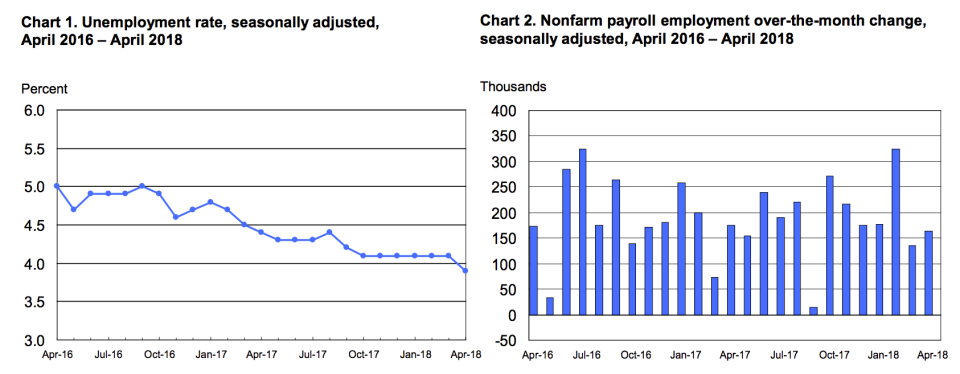Unemployment rate falls to 3.9% in April, job gains miss expectations
The April jobs report is out and it’s a mixed bag.
In April, the U.S. economy added 164,000 jobs while the unemployment rate fell to 3.9%, according to the latest data from the Bureau of Labor Statistics. This unemployment rate matches a level last seen in December 2000.
Nonfarm payrolls were expected to have grown by 193,000 in April with the unemployment rate forecast to fall to 4%, according to estimates from Bloomberg. This decline in the unemployment rate breaks a six-month streak of the unemployment rate sitting at 4.1%.

Other key numbers economists were watching out for in Friday’s report were wage gains, which tallied 0.1% over the prior month and 2.6% over the same month last year in April.
Economists had forecast a 0.2% and 2.7% increase in monthly and annual wage gains, respectively.
An increase in wages is seen as a sign of potential inflation pressures building in the economy. In March, the Fed’s preferred measure of inflation showed a 1.9% increase over the prior year.
In its monetary policy statement released Wednesday, the Fed acknowledged that inflation has “moved close to 2 percent,” a change from its previous language acknowledging price increases running consistently below its 2% target.
Neil Dutta, an economist at Renaissance Macro, said after Friday’s report that it’s time to cut estimates for NAIRU — or the non-accelerating inflation rate of unemployment — as a 3.9% unemployment rate with a 2.6% annual increase in wages is far outside what most economists expected possible a few years ago. Unemployment rates at these levels, in other words, were expected in the past to bring about rapidly rising wages; a 2.6% annual increase in pay is not a rapid increase.

Following Friday’s report, U.S. stock futures were lower with Dow futures off about 90 points, or 0.4%, S&P 500 futures down 10 points, or 0.4%, and Nasdaq futures down 32 points, or 0.5%.
U.S. Treasury yields were rallying, with the 2-year yield down to 2.46% and the 10-year down to 2.91%. Last week, the 10-year broke above 3% for the first time in four years.
Elsewhere in Friday’s jobs report, the labor force participation slid backwards, moving to 62.8% from 62.9%, indicating that growing the U.S. labor pool substantially still remains a challenge even a decade after the onset of the financial crisis.
The underemployment rate, which captures those working part-time but who would like full-time work, fell to 7.8% in April from 8% in March. The Trump administration had signaled last year that it was focused on bringing this number down.
In March, nonfarm payroll growth slowed to a six-month low as the economy added just 103,000 jobs during the final month of the first quarter. On Friday, these numbers were revised higher to indicate the economy added 135,000 jobs in March.
Including Friday’s revisions, job gains have now averaged 208,000 over the last three months.
Following the March jobs report, however, economists noted that 100,000 new jobs each month is potentially all that the U.S. economy will need to create given the growth of the workforce and the low level of unemployment.
—
Myles Udland is a writer at Yahoo Finance. Follow him on Twitter @MylesUdland
—
Watch Warren Buffett LIVE at the 2018 Berkshire Hathaway Annual Shareholders Meeting exclusively on the Yahoo Finance app and desktop. Coverage begins May 5 at 9:45am ET. Set a reminder now!

